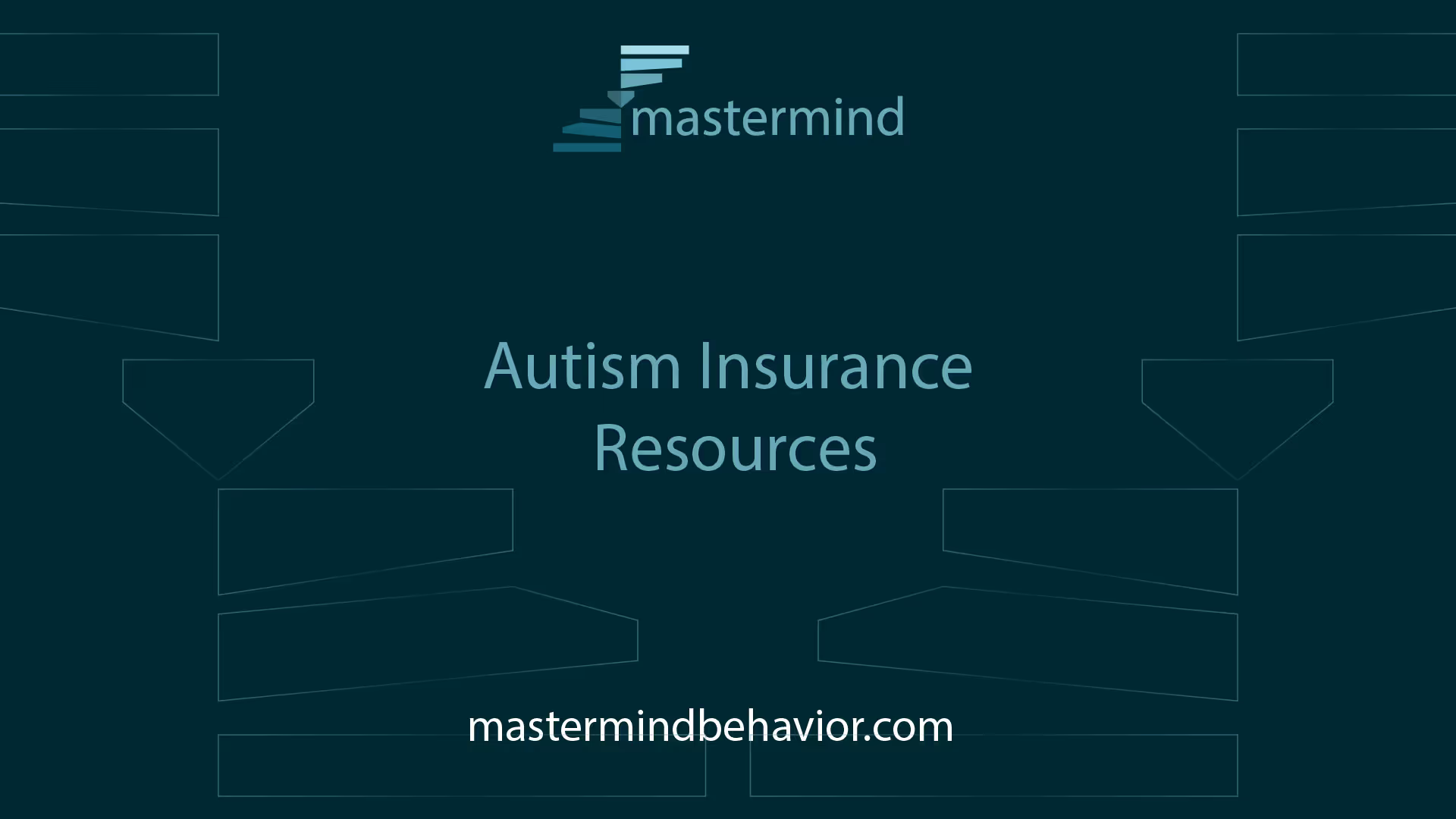Is Autism Covered by Your Health Insurance?

Understanding Autism Insurance Coverage

Navigating the complexities of health insurance coverage for autism treatment can be challenging for many families. This section explores both the advocacy efforts that have made significant strides in securing coverage and the complexities involved in understanding what is covered.
Advocacy Efforts for Coverage
Over the past decade, advocacy groups like Autism Speaks have played a crucial role in improving health insurance coverage for medically necessary treatments, such as Applied Behavior Analysis (ABA). Due to these efforts, at least 200 million people now have health insurance coverage for ABA services. Advocacy has focused on ensuring that health plans include essential autism treatments to give children the best chance to thrive.
The push for better coverage has led to significant legislative changes across many states. Most states now require insurers to provide coverage for the treatment of autism, although the specifics of this coverage can vary widely. These mandates ensure that treatments like ABA are accessible to many families, reducing out-of-pocket expenses and financial stress.
Complexity of Insurance Coverage
Understanding whether autism is covered by health insurance involves navigating a maze of variables, including age groups, annual visit limits, spending caps, and other restrictions. Most states have specific mandates, but the coverage details can differ significantly [2].
Table data courtesy of NCSL
The coverage required for autism treatment may not be subject to dollar limits, deductibles, or coinsurance provisions that are less favorable than those that apply to other illnesses under the health insurance plan in some states. This means that while some states offer robust coverage with minimal restrictions, others may impose more stringent limits.
Additionally, the increase in state insurance mandates has correlated with a 16% rise in board-certified behavioral analysts, according to the American Academy of Pediatrics. This indicates that more specialized care is becoming available, thanks to these legislative efforts.
For more information on autism treatment breakthroughs and services, you can explore our article on autism treatment breakthrough. If you're considering various care options for your child, you might find our guide on can I put my autistic child into care helpful.
Understanding the intricacies of autism insurance coverage is essential for accessing the best possible care for your child. By staying informed and advocating for comprehensive coverage, families can ensure that their children receive the necessary support to thrive.
Autism Insurance Resources

When seeking to determine if autism is covered by health insurance, knowing where to find reliable resources can make a significant difference. This section provides valuable information on online assistance and guidance on how to ascertain your coverage.
Online Assistance
Several online resources offer comprehensive assistance for individuals seeking information about autism insurance coverage. One notable organization is Autism Speaks. They provide online resources and staff to help individuals determine if their health benefit plan provides meaningful coverage for the treatment of autism. Additionally, they offer assistance with the effective implementation and enforcement of entitled benefits.
These platforms are designed to help parents and caregivers navigate the complexities of insurance coverage for autism treatment. By leveraging these resources, you can better understand your entitlements and the steps necessary to secure them.
Determining Coverage
Determining whether your health insurance covers autism treatment involves several steps. Here are some key points to consider:
- Review Your Policy: Start by thoroughly reviewing your health insurance policy. Look for sections that mention behavioral health, mental health treatment, or specific autism-related services.
- Contact Your Insurer: Reach out to your insurance provider directly. Ask detailed questions about what autism treatments are covered, any limitations, and the process for obtaining pre-authorization if required.
- State-Specific Mandates: Be aware of state-specific mandates that may affect your coverage. For example, in California, all health care service plan contracts are required to cover behavioral health treatment, including applied behavior analysis (ABA) and other evidence-based interventions.
- Utilize Advocacy Organizations: Organizations like Autism Speaks can provide guidance on how to approach your insurer and advocate for the coverage you need. They can also help with the appeals process if your initial request for coverage is denied.
- Legal Advice: In some cases, seeking legal advice may be necessary to ensure that your rights are protected and that you are receiving the coverage mandated by law.
By following these steps and utilizing available resources, you can effectively determine whether your health insurance covers autism treatment. For more information on the financial aspects and other related topics, check out our articles on the financial impact of autism and cost of interventions.
Navigating Health Benefit Plans
Understanding the type of health benefit plan you have is crucial in determining which autism-related health benefits are covered. It also impacts how to advocate for changes in benefits, appeal denials, and file complaints if dissatisfied.
Types of Health Plans
Health benefit plans vary widely, and each type has specific rules regarding coverage for autism treatments, such as Applied Behavior Analysis (ABA) therapy. The main types of health plans include:
- Employer-Sponsored Plans: These are offered through an individual's employer. Coverage for autism services can vary significantly depending on the employer's chosen plan.
- Individual Health Plans: These are purchased by individuals directly from insurance companies. Coverage is often influenced by state mandates.
- Medicaid: A government program providing health coverage to low-income individuals, including specific autism services in many states.
- Children's Health Insurance Program (CHIP): Similar to Medicaid, CHIP provides coverage for children from low-income families, often including autism services.
- Marketplace Plans: These are plans offered through the Health Insurance Marketplace. Coverage can vary based on the plan's metal tier (Bronze, Silver, Gold, Platinum).
Advocating for Change
Advocating for better autism coverage involves understanding your health plan and knowing how to push for necessary changes. Here are some steps to follow:
- Review Your Plan: Start by thoroughly reviewing your health plan's coverage details. Understand what is included and what is excluded.
- Document Denials: Keep records of any denied claims or services. This documentation is crucial when appealing denials.
- File Appeals: If a claim is denied, file an appeal with your insurance company. Include all necessary documentation and a clear explanation of why the service should be covered.
- Know Your Rights: Familiarize yourself with state-specific mandates and federal laws that require coverage for autism services. This information can be found on resources like Autism Speaks and the Missouri Department of Commerce & Insurance.
- Seek Support: Engage with advocacy groups and legal resources that specialize in autism coverage. These groups can provide guidance and support throughout the process.
For more detailed guidance on navigating health benefit plans and advocating for autism coverage, visit our articles on autism treatment breakthrough, autism elderly care, and what is respite care autism.
Understanding the intricacies of health benefit plans and advocating for necessary changes can significantly improve access to essential autism services, allowing children with autism the chance to thrive.
State-Specific Coverage Mandates

Missouri Autism Coverage
Missouri has established comprehensive coverage mandates for autism treatment under group health insurance policies. The law mandates private insurance companies to provide coverage for various forms of care, including psychiatric, psychological, habilitative, and rehabilitative care. This encompasses applied behavior analysis (ABA) therapy, therapeutic, and pharmacy care for children diagnosed with autism spectrum disorder (ASD) [3].
Missouri's law specifies that the benefit for ABA therapy is capped at $41,263 per year for children until their 19th birthday. Importantly, there are no annual limits on the number of visits. The therapy must be prescribed by a physician or psychologist and detailed in a treatment plan subject to biannual reviews [3].
For more information on the financial aspects of autism treatment, refer to our section on medical expenditures.
California Autism Coverage
In California, all health care service plan contracts providing hospital, medical, or surgical coverage are required to cover behavioral health treatments for pervasive developmental disorder or autism. This includes professional services and treatment programs like ABA therapy, evidence-based behavior intervention programs, speech-language pathology, and audiology [4].
California’s insurance policies must provide coverage without exceeding the essential health benefits required by the Patient Protection and Affordable Care Act [2].
For further details on navigating health benefit plans specific to autism, visit our article on navigating health benefit plans.
By understanding state-specific mandates, parents and caregivers can better navigate the complexities of health insurance coverage for autism treatment. For more on the cost of interventions, explore our section on the financial impact of autism.
Financial Impact of Autism
Autism Spectrum Disorder (ASD) has significant financial implications for families and health systems. Understanding these costs can help caregivers navigate the complexities of insurance coverage and seek the necessary resources for their loved ones.
Medical Expenditures
Studies indicate that individuals with ASD incur higher medical expenditures compared to those without disabilities [5]. The lack of health insurance further exacerbates these costs, making it essential for families to secure coverage for autism treatment.
The above table highlights the significant financial burden faced by families of children with ASD. These costs include health care, education, ASD-related therapy, family-coordinated services, and caregiver time [2].
Cost of Interventions
Therapeutic interventions, outpatient visits, and medications make up the largest proportion of direct medical expenditure for individuals with ASD [5]. Intensive behavioral interventions, such as Applied Behavior Analysis (ABA) therapy, are particularly costly but essential for the development and well-being of children with autism.
Given the high costs associated with autism treatment, it is crucial for families to understand whether autism is covered by health insurance. Most states have mandates requiring insurers to cover autism treatment, though the specifics of coverage can vary widely, including age groups, number of annual visits, and spending caps [2].
For more information on financial support and state-specific mandates, explore our articles on what is respite care autism and can i put my autistic child into care.
Impact of Coverage Mandates
Increase in Behavioral Analysts
State insurance mandates for autism coverage have significantly impacted the availability of specialized care. According to the American Academy of Pediatrics, these mandates have been associated with a 16% increase in board-certified behavioral analysts [2]. This increase reflects the growing demand for professionals who can provide Applied Behavior Analysis (ABA) therapy, a widely recognized and effective treatment for children with autism.
The rise in behavioral analysts is crucial for improving access to quality care. These professionals play a key role in delivering personalized interventions that can help children with autism develop essential skills and thrive in everyday environments. For families in New Jersey seeking in-home ABA services, the availability of certified analysts can make a significant difference in their child's progress.
State Approaches to Autism Coverage
States have adopted various approaches to ensure that health insurance plans cover autism treatment. Most states require insurers to provide coverage, but the specifics can vary widely. These variances include age groups covered, number of annual visits allowed, annual spending caps, and other limitations [2].
These mandates ensure that children and adults with autism have access to necessary treatments, such as behavioral and educational interventions, complementary and alternative medicine, dietary changes, and medications. The average medical expenditures for a child with Autism Spectrum Disorder (ASD) exceed those without by $4,110 to $6,200 per year, with additional costs for intensive behavioral interventions ranging from $40,000 to $60,000 per child per year.
For more information on the financial impact of autism and the different state-specific mandates, you can refer to our articles on autism treatment breakthrough and what is respite care autism.
By understanding the impact of coverage mandates, families can better navigate the complexities of health insurance and advocate for the necessary support to help their children thrive.
References
[1]: https://www.autismspeaks.org/health-insurance
[2]: https://www.ncsl.org/health/autism-and-insurance-coverage-state-laws
[3]: https://insurance.mo.gov/consumers/autismFAQ/
[4]: https://www.asha.org/advocacy/state/states-specific-autism-mandates/
Recent articles

How to Encourage Teamwork and Group Participation in Children with Autism
Fostering Collaborative Skills for Children on the Autism Spectrum

How to Choose Between Comprehensive and Focused ABA Therapy
Making Informed Decisions for Autism Treatment

How ABA Therapy Supports School Readiness and Academic Success
Building Foundations for Success: The Role of ABA in School Readiness and Learning

How ABA Therapy Supports School Readiness and Academic Success
Building Foundations for Success: The Role of ABA in School Readiness and Learning

How ABA Therapy Supports School Readiness and Academic Success
Building Foundations for Success: The Role of ABA in School Readiness and Learning

How to Find the Right ABA Therapy Program for Your Child
Navigating Choices: A Comprehensive Guide to Finding the Best ABA Program for Your Child


